Founded in 1938 and published semiannually by Sophia University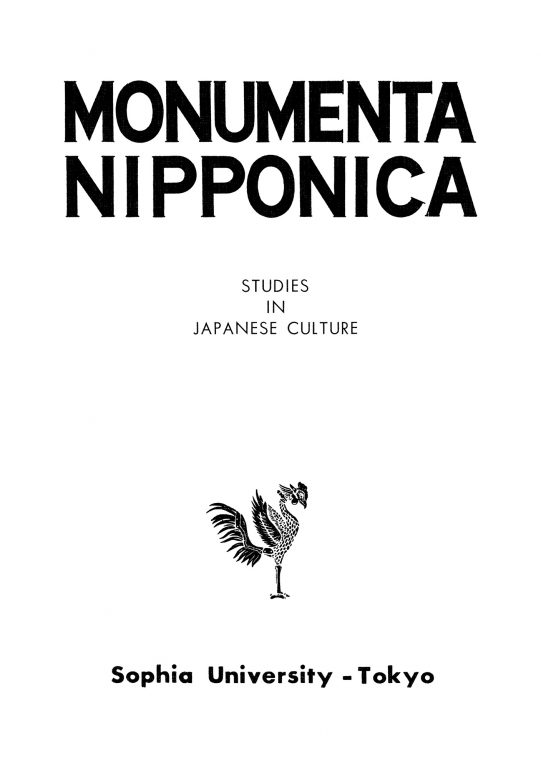 MN 13:3/4 (1957) 329–46Das Merkbuch für die Übung des Zazen des Zen-Meisters KeizanTranslated by Heinrich Dumoulin
MN 13:3/4 (1957) 329–46Das Merkbuch für die Übung des Zazen des Zen-Meisters KeizanTranslated by Heinrich Dumoulin MN 13:1/2 (1957) 101–27Yasen Kanna: A Chat on a Boat in the EveningR. D. M. Shaw and Wilhelm Schiffer
MN 13:1/2 (1957) 101–27Yasen Kanna: A Chat on a Boat in the EveningR. D. M. Shaw and Wilhelm Schiffer MN 13:1/2 (1957) 106–27Yasen Kanna: Preface to a Chat on a Boat in the EveningHakuin Zenji, Translated by R. D. M. Shaw and Wilhelm Schiffer
MN 13:1/2 (1957) 106–27Yasen Kanna: Preface to a Chat on a Boat in the EveningHakuin Zenji, Translated by R. D. M. Shaw and Wilhelm Schiffer MN 13:1/2 (1957) 129–52Honchō-shinsen-denHermann Bohner
MN 13:1/2 (1957) 129–52Honchō-shinsen-denHermann Bohner MN 13:1/2 (1957) 139–52En no GyōjaTranslated by Hermann Bohner
MN 13:1/2 (1957) 139–52En no GyōjaTranslated by Hermann Bohner MN 13:1/2 (1957) 153–62Modern Japanese Religions: Their Success ExplainedBaiyū Watanabe
MN 13:1/2 (1957) 153–62Modern Japanese Religions: Their Success ExplainedBaiyū Watanabe MN 13:1/2 (1957) 163–65The Jesuit Mission Press in JapanJohannes Laures
MN 13:1/2 (1957) 163–65The Jesuit Mission Press in JapanJohannes Laures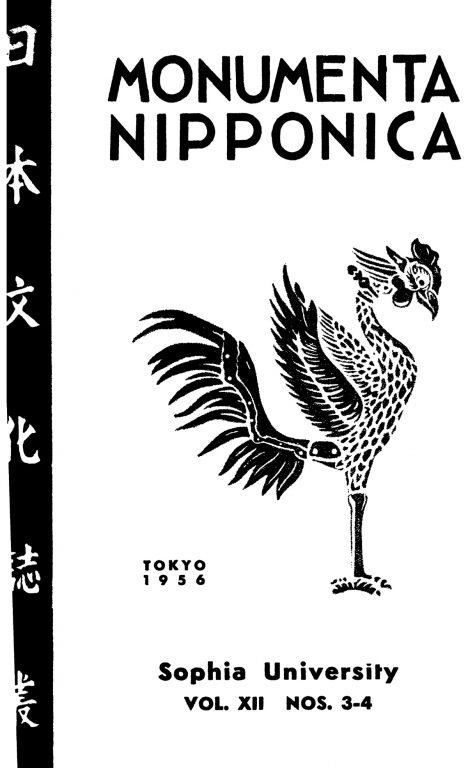 MN 12:3/4 (1956) 241–68The World Conception of Chu Tao-sheng (Part 2)Walter Liebenthal
MN 12:3/4 (1956) 241–68The World Conception of Chu Tao-sheng (Part 2)Walter Liebenthal MN 12:3/4 (1956) 269–98Kamo Mabuchis Erklärung des Norito zum Toshi-goi-no-matsuri (Part 2)Kamo no Mabuchi, Translated by Heinrich Dumoulin
MN 12:3/4 (1956) 269–98Kamo Mabuchis Erklärung des Norito zum Toshi-goi-no-matsuri (Part 2)Kamo no Mabuchi, Translated by Heinrich Dumoulin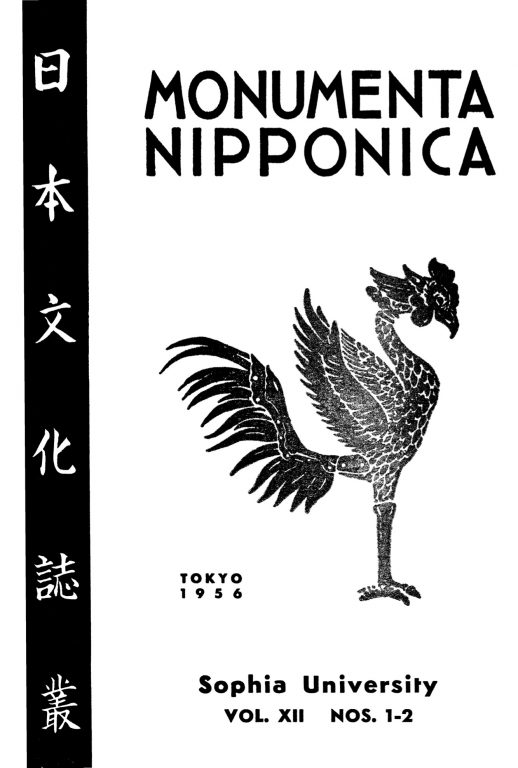 MN 12:1/2 (1956) 1–11L’Apport spirituel de l’Extrême-Orient: Quelques réflexions personnellesPierre Teilhard de Chardin
MN 12:1/2 (1956) 1–11L’Apport spirituel de l’Extrême-Orient: Quelques réflexions personnellesPierre Teilhard de Chardin MN 12:1/2 (1956) 51–63Verwünschung in der altjapanischen KultspracheAnton Lämmerhirt
MN 12:1/2 (1956) 51–63Verwünschung in der altjapanischen KultspracheAnton Lämmerhirt MN 12:1/2 (1956) 65–103The World Conception of Chu Tao-sheng (Part 1)Walter Liebenthal
MN 12:1/2 (1956) 65–103The World Conception of Chu Tao-sheng (Part 1)Walter Liebenthal MN 12:1/2 (1956) 121–56Kamo Mabuchis Erklärung des Norito zum Toshi-goi-no-matsuri (Part 1)Kamo no Mabuchi, Translated by Heinrich Dumoulin
MN 12:1/2 (1956) 121–56Kamo Mabuchis Erklärung des Norito zum Toshi-goi-no-matsuri (Part 1)Kamo no Mabuchi, Translated by Heinrich Dumoulin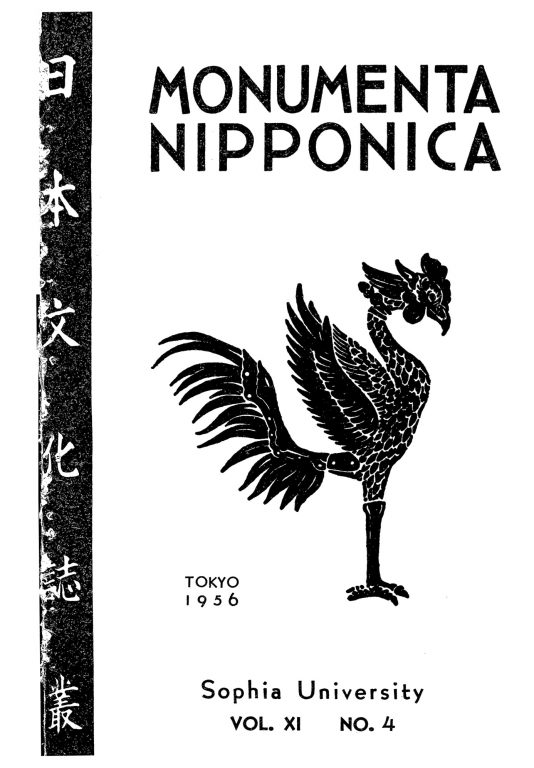 MN 11:4 (1956) 356–96Gebet in der altjapanischen KultspracheAnton Lämmerhirt
MN 11:4 (1956) 356–96Gebet in der altjapanischen KultspracheAnton Lämmerhirt MN 11:4 (1956) 397–424Japanese Research on Buddhism Since the Meiji Period (Part 2)A. Hirakawa and E. B. Ceadel
MN 11:4 (1956) 397–424Japanese Research on Buddhism Since the Meiji Period (Part 2)A. Hirakawa and E. B. Ceadel MN 11:3 (1955) 221–46Japanese Research on Buddhism Since the Meiji Period (Part 1)A. Hirakawa and E. B. Ceadel
MN 11:3 (1955) 221–46Japanese Research on Buddhism Since the Meiji Period (Part 1)A. Hirakawa and E. B. Ceadel MN 11:3 (1955) 284–316A Biography of Chu Tao-ShengWalter Liebenthal
MN 11:3 (1955) 284–316A Biography of Chu Tao-ShengWalter Liebenthal MN 11:2 (1955) 170–84Main Trends of Contemporary Japanese PhilosophyGino K. Piovesana
MN 11:2 (1955) 170–84Main Trends of Contemporary Japanese PhilosophyGino K. Piovesana MN 11:2 (1955) 185–94Revisions in the Rakuyōshū at the Time of Its Printing in 1598Joseph Koshimi Yamagiwa
MN 11:2 (1955) 185–94Revisions in the Rakuyōshū at the Time of Its Printing in 1598Joseph Koshimi Yamagiwa MN 11:2 (1955) 214Second Supplement to Kirishitan BunkoJohannes Laures
MN 11:2 (1955) 214Second Supplement to Kirishitan BunkoJohannes Laures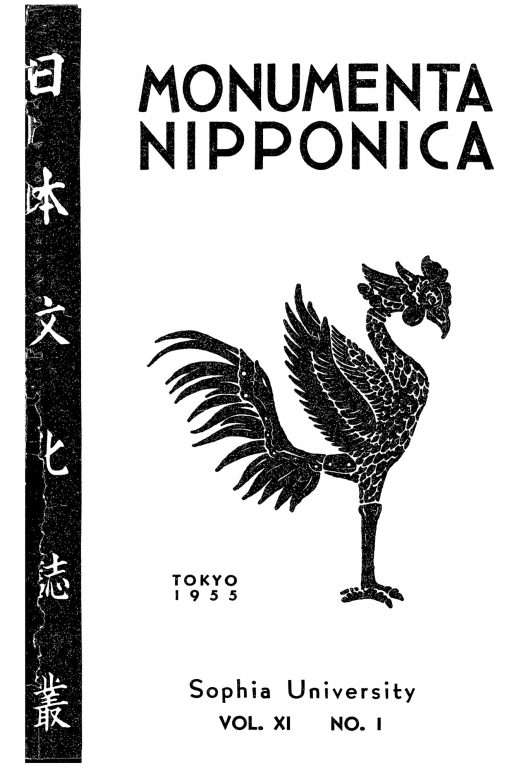 MN 11:1 (1955) 1–14New Religions in Postwar JapanWilhelm Schiffer
MN 11:1 (1955) 1–14New Religions in Postwar JapanWilhelm Schiffer MN 11:1 (1955) 44–83Chinese Buddhism During the 4th and 5th CenturiesWalter Liebenthal
MN 11:1 (1955) 44–83Chinese Buddhism During the 4th and 5th CenturiesWalter Liebenthal MN 10:1/2 (1954) 1–44The Great Martyrdom in Edo 1623: Its Causes, Course, ConsequencesHubert Cieslik
MN 10:1/2 (1954) 1–44The Great Martyrdom in Edo 1623: Its Causes, Course, ConsequencesHubert Cieslik MN 10:1/2 (1954) 107–26The Sumu-Sanu Myth: Notes and Remarks on the Jimmu Tennō MythBoleslaw Szczesniak
MN 10:1/2 (1954) 107–26The Sumu-Sanu Myth: Notes and Remarks on the Jimmu Tennō MythBoleslaw Szczesniak MN 10:1/2 (1954) 227–69A Chapter on Reality From the Madhyāntavibhāgaçāstra (Part 2)Translated by Paul Wilfred O'Brien
MN 10:1/2 (1954) 227–69A Chapter on Reality From the Madhyāntavibhāgaçāstra (Part 2)Translated by Paul Wilfred O'Brien MN 9:1/2 (1953) 83–108L’orientaliste Guillaume Postel et la découverte spirituelle du Japon en 1552Henri Bernard-Maitre
MN 9:1/2 (1953) 83–108L’orientaliste Guillaume Postel et la découverte spirituelle du Japon en 1552Henri Bernard-Maitre MN 9:1/2 (1953) 277–303A Chapter on Reality from the Madhyāntavibhāgaçāstra (Part 1)Paul Wilfred O'Brien
MN 9:1/2 (1953) 277–303A Chapter on Reality from the Madhyāntavibhāgaçāstra (Part 1)Paul Wilfred O'Brien MN 9:1/2 (1953) 284–303A Commentary on Discrimination Between the Mean and Extremes By the Bodhisattva Vasubandhu, Translated Under Imperial Command by Hsüan Tsang Tripitaka Master of the T’ang Dynasty, Chapter the Third: A Discussion of Reality (Tattva)Translated by Paul Wilfred O'Brien
MN 9:1/2 (1953) 284–303A Commentary on Discrimination Between the Mean and Extremes By the Bodhisattva Vasubandhu, Translated Under Imperial Command by Hsüan Tsang Tripitaka Master of the T’ang Dynasty, Chapter the Third: A Discussion of Reality (Tattva)Translated by Paul Wilfred O'Brien MN 9:1/2 (1953) 330–56Samidare-shō (Part 2)Miura Baien and Miura Susumu, Translated by Leon Hurvitz
MN 9:1/2 (1953) 330–56Samidare-shō (Part 2)Miura Baien and Miura Susumu, Translated by Leon Hurvitz MN 8:1/2 (1952) 289–326Samidare-Shō (Part 1)Miura Baien, Translated by Leon Hurvitz
MN 8:1/2 (1952) 289–326Samidare-Shō (Part 1)Miura Baien, Translated by Leon Hurvitz MN 8:1/2 (1952) 327–97The Immortality of the Soul in Chinese ThoughtWalter Liebenthal
MN 8:1/2 (1952) 327–97The Immortality of the Soul in Chinese ThoughtWalter Liebenthal MN 8:1/2 (1952) 340–97DocumentsTranslated by Walter Liebenthal
MN 8:1/2 (1952) 340–97DocumentsTranslated by Walter Liebenthal MN 8:1/2 (1952) 407–11Notes on the Death of Ninshitsu, Xavier’s Bonze FriendJohannes Laures
MN 8:1/2 (1952) 407–11Notes on the Death of Ninshitsu, Xavier’s Bonze FriendJohannes Laures MN 7:1/2 (1951) 67–83Bodhidharma und die Anfänge des Ch’an-BuddhismusHeinrich Dumoulin
MN 7:1/2 (1951) 67–83Bodhidharma und die Anfänge des Ch’an-BuddhismusHeinrich Dumoulin MN 7:1/2 (1951) 84–101Die Zahl der Christen und Martyrer im alten JapanJohannes Laures
MN 7:1/2 (1951) 84–101Die Zahl der Christen und Martyrer im alten JapanJohannes Laures MN 7:1/2 (1951) 102–55Die Goningumi im Dienste der ChristenüberwachungHubert Cieslik
MN 7:1/2 (1951) 102–55Die Goningumi im Dienste der ChristenüberwachungHubert Cieslik MN 7:1/2 (1951) 269–99Second Supplement to Kirishitan BunkoJohannes Laures
MN 7:1/2 (1951) 269–99Second Supplement to Kirishitan BunkoJohannes Laures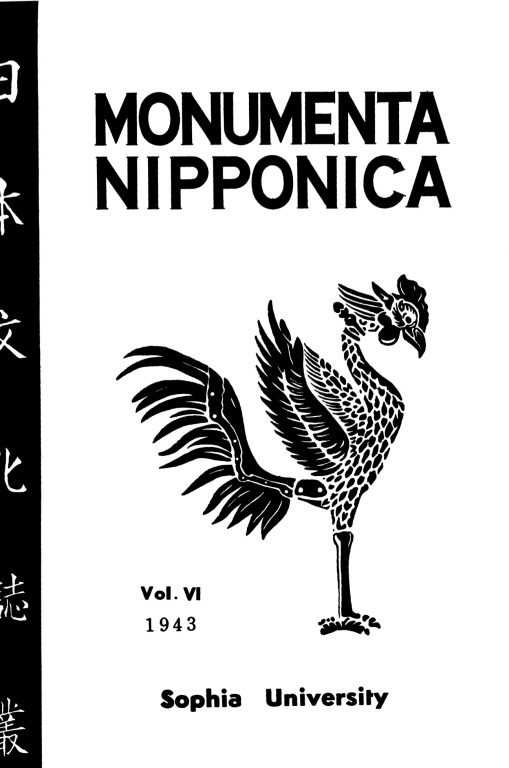 MN 6:1/2 (1943) 1–12The Foundation of Buddhist Culture in Japan: The Buddhist Ideals as conceived and carried out by the Price-Regent ShōtokuMasaharu Anesaki
MN 6:1/2 (1943) 1–12The Foundation of Buddhist Culture in Japan: The Buddhist Ideals as conceived and carried out by the Price-Regent ShōtokuMasaharu Anesaki MN 6:1/2 (1943) 13–51Nanbanji-Romane der Tokugawa-ZeitHubert Cieslik
MN 6:1/2 (1943) 13–51Nanbanji-Romane der Tokugawa-ZeitHubert Cieslik MN 6:1/2 (1943) 146–71in der altjapanischen Literatur: Hochsprache und Mundarten der NaraperiodeOtto Karow
MN 6:1/2 (1943) 146–71in der altjapanischen Literatur: Hochsprache und Mundarten der NaraperiodeOtto Karow MN 6:1/2 (1943) 202–18Mokujiki Gogyō Shōnin: Bonze und Bildschnitzer der EdozeitJoseph Roggendorf and Sōetsu Yanagi
MN 6:1/2 (1943) 202–18Mokujiki Gogyō Shōnin: Bonze und Bildschnitzer der EdozeitJoseph Roggendorf and Sōetsu Yanagi MN 6:1/2 (1943) 266–313Kōbō DaishiHermann Bohner
MN 6:1/2 (1943) 266–313Kōbō DaishiHermann Bohner MN 6:1/2 (1943) 287–95Kūkai-Sōzu-den (Biographie des Sōzu Kūkai)Shinzai, Translated by Hermann Bohner
MN 6:1/2 (1943) 287–95Kūkai-Sōzu-den (Biographie des Sōzu Kūkai)Shinzai, Translated by Hermann Bohner MN 6:1/2 (1943) 296–99Zō-daisōjō-Kūkai-wajō-denki (Biographie des zum Erzbischof erhobenen Ehrwürdigen Kūkai)Translated by Hermann Bohner
MN 6:1/2 (1943) 296–99Zō-daisōjō-Kūkai-wajō-denki (Biographie des zum Erzbischof erhobenen Ehrwürdigen Kūkai)Translated by Hermann Bohner MN 6:1/2 (1943) 300–13Go-yui-Gō (Abschiedsworte)Translated by Hermann Bohner
MN 6:1/2 (1943) 300–13Go-yui-Gō (Abschiedsworte)Translated by Hermann Bohner MN 6:1/2 (1943) 355–69Shushōgi: Prinzipien der Übung und Erleuchtung: Eine Zenschrift für LaienK. Ishimoto and P. E. Naberfeld
MN 6:1/2 (1943) 355–69Shushōgi: Prinzipien der Übung und Erleuchtung: Eine Zenschrift für LaienK. Ishimoto and P. E. Naberfeld MN 6:1/2 (1943) 361–69KapitelTranslated by K. Ishimoto and P. E. Naberfeld
MN 6:1/2 (1943) 361–69KapitelTranslated by K. Ishimoto and P. E. Naberfeld MN 6:1/2 (1943) 370–74The Jesuit Seminary of AzuchiNaojirō Murakami
MN 6:1/2 (1943) 370–74The Jesuit Seminary of AzuchiNaojirō Murakami












